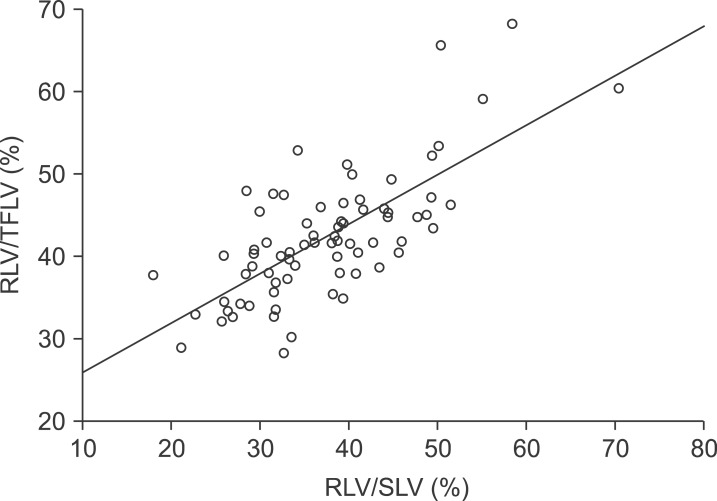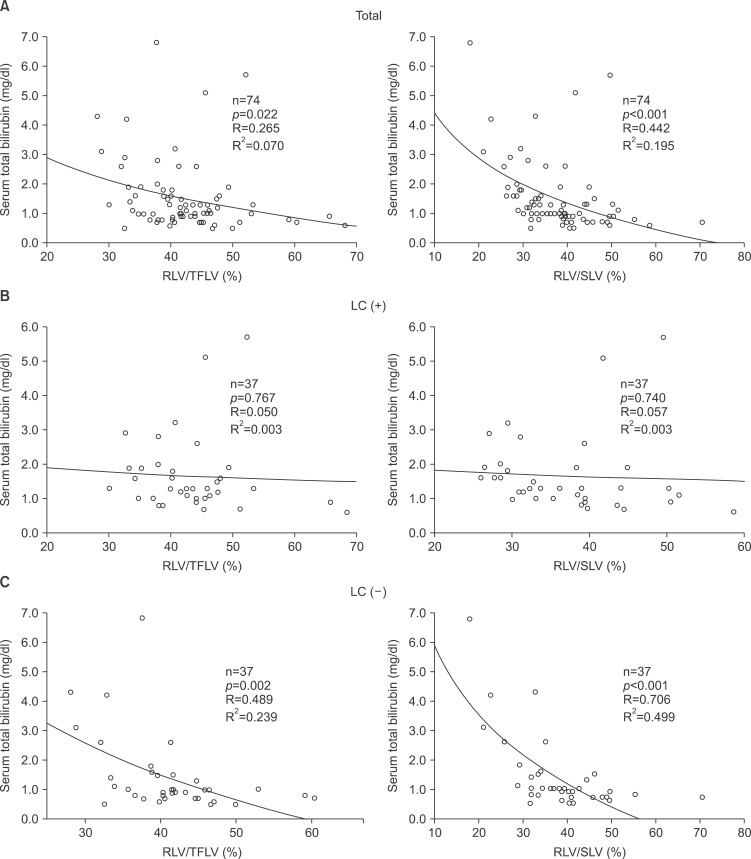Korean J Hepatobiliary Pancreat Surg.
2013 Nov;17(4):143-151. 10.14701/kjhbps.2013.17.4.143.
Comparison of remnant to total functional liver volume ratio and remnant to standard liver volume ratio as a predictor of postoperative liver function after liver resection
- Affiliations
-
- 1Department of Surgery, Chonnam National University College of Medicine, Gwangju, Korea. ckcho@jnu.ac.kr
- KMID: 2083338
- DOI: http://doi.org/10.14701/kjhbps.2013.17.4.143
Abstract
- BACKGROUNDS/AIMS
The future liver remnant (FLR) is usually calculated as a ratio of the remnant liver volume (RLV) to the total functional liver volume (RLV/TFLV). In liver transplantation, it is generally accepted that the ratio of the graft volume to standard liver volume (SLV) needs to be at least 30% to 40% to fit the hepatic metabolic demands of the recipient. The aim of this study was to compare RLV/TFLV versus RLV/SLV as a predictor of postoperative liver function and liver failure.
METHODS
CT volumetric measurements of RLV were obtained retrospectively in 74 patients who underwent right hemihepatectomy for a malignant tumor from January 2010 to May 2013. RLV and TFLV were obtained using CT volumetry, and SLV was calculated using Yu's formula: SLV (ml)=21.585 x body weight (kg)0.732 x height (cm)0.225. The RLV/SLV ratio was compared with the RLV/TFLV as a predictor of postoperative hepatic function.
RESULTS
Postheptectomy liver failure (PHLF), morbidity, and serum total bilirubin level at postoperative day 5 (POD 5) were increased significantly in the group with the RLV/SLV < or =30% compared with the group with the RLV/SLV >30% (p=0.002, p=0.004, and p<0.001, respectively). But RLV/TFLV was not correlated with PHLF and morbidity (p=1.000 and 0.798, respectively). RLV/SLV showed a stronger correlation with serum total bilirubin level than RLV/TFLV (RLV/SLV vs. RLV/TFLV, R=0.706 vs. 0.499, R2=0.499 vs. 0.239).
CONCLUSIONS
RLV/SLV was more specific than RLV/TFLV in predicting the postoperative course after right hemihepatectomy. To determine the safe limit of hepatic resection, a larger-scaled prospective study is needed.
MeSH Terms
Figure
Reference
-
1. Benzoni E, Lorenzin D, Baccarani U, et al. Resective surgery for liver tumor: a multivariate analysis of causes and risk factors linked to postoperative complications. Hepatobiliary Pancreat Dis Int. 2006; 5:526–533. PMID: 17085337.2. Schroeder RA, Marroquin CE, Bute BP, et al. Predictive indices of morbidity and mortality after liver resection. Ann Surg. 2006; 243:373–379. PMID: 16495703.
Article3. Paugam-Burtz C, Janny S, Delefosse D, et al. Prospective validation of the "fifty-fifty" criteria as an early and accurate predictor of death after liver resection in intensive care unit patients. Ann Surg. 2009; 249:124–128. PMID: 19106687.
Article4. Ogasawara K, Une Y, Nakajima Y, et al. The significance of measuring liver volume using computed tomographic images before and after hepatectomy. Surg Today. 1995; 25:43–48. PMID: 7749289.
Article5. Kubota K, Makuuchi M, Kusaka K, et al. Measurement of liver volume and hepatic functional reserve as a guide to decision-making in resectional surgery for hepatic tumors. Hepatology. 1997; 26:1176–1181. PMID: 9362359.
Article6. Guglielmi A, Ruzzenente A, Conci S, et al. How much remnant is enough in liver resection? Dig Surg. 2012; 29:6–17. PMID: 22441614.
Article7. Lo CM, Fan ST, Liu CL, et al. Minimum graft size for successful living donor liver transplantation. Transplantation. 1999; 68:1112–1116. PMID: 10551638.
Article8. Kawasaki S, Makuuchi M, Matsunami H, et al. Preoperative measurement of segmental liver volume of donors for living related liver transplantation. Hepatology. 1993; 18:1115–1120. PMID: 8225216.
Article9. Nishizaki T, Ikegami T, Hiroshige S, et al. Small graft for living donor liver transplantation. Ann Surg. 2001; 233:575–580. PMID: 11303141.
Article10. Kawasaki S, Makuuchi M, Matsunami H, et al. Living related liver transplantation in adults. Ann Surg. 1998; 227:269–274. PMID: 9488526.
Article11. Chen CL, Fan ST, Lee SG, et al. Living-donor liver transplantation: 12 years of experience in Asia. Transplantation. 2003; 75(3 Suppl):S6–S11. PMID: 12589130.
Article12. Hemming AW, Scudamore CH, Shackleton CR, et al. Indocyanine green clearance as a predictor of successful hepatic resection in cirrhotic patients. Am J Surg. 1992; 163:515–518. PMID: 1575310.
Article13. Fan ST, Lai EC, Lo CM, et al. Hospital mortality of major hepatectomy for hepatocellular carcinoma associated with cirrhosis. Arch Surg. 1995; 130:198–203. PMID: 7848092.
Article14. Balzan S, Belghiti J, Farges O, et al. The "50-50 criteria" on postoperative day 5: an accurate predictor of liver failure and death after hepatectomy. Ann Surg. 2005; 242:824–828. PMID: 16327492.15. Rahbari NN, Garden OJ, Padbury R, et al. Posthepatectomy liver failure: a definition and grading by the International Study Group of Liver Surgery (ISGLS). Surgery. 2011; 149:713–724. PMID: 21236455.
Article16. Yu HC, You H, Lee H, et al. Estimation of standard liver volume for liver transplantation in the Korean population. Liver Transpl. 2004; 10:779–783. PMID: 15162473.
Article17. Shoup M, Gonen M, D'Angelica M, et al. Volumetric analysis predicts hepatic dysfunction in patients undergoing major liver resection. J Gastrointest Surg. 2003; 7:325–330. PMID: 12654556.
Article18. Abdalla EK, Vauthey JN, Ellis LM, et al. Recurrence and outcomes following hepatic resection, radiofrequency ablation, and combined resection/ablation for colorectal liver metastases. Ann Surg. 2004; 239:818–825. PMID: 15166961.
Article19. Vauthey JN, Chaoui A, Do KA, et al. Standardized measurement of the future liver remnant prior to extended liver resection: methodology and clinical associations. Surgery. 2000; 127:512–519. PMID: 10819059.
Article20. Ribero D, Abdalla EK, Madoff DC, et al. Portal vein embolization before major hepatectomy and its effects on regeneration, resectability and outcome. Br J Surg. 2007; 94:1386–1394. PMID: 17583900.
Article21. Kishi Y, Abdalla EK, Chun YS, et al. Three hundred and one consecutive extended right hepatectomies: evaluation of outcome based on systematic liver volumetry. Ann Surg. 2009; 250:540–548. PMID: 19730239.22. Vauthey JN, Abdalla EK, Doherty DA, et al. Body surface area and body weight predict total liver volume in Western adults. Liver Transpl. 2002; 8:233–240. PMID: 11910568.
Article23. Vauthey JN, Pawlik TM, Abdalla EK, et al. Is extended hepatectomy for hepatobiliary malignancy justified? Ann Surg. 2004; 239:722–730. PMID: 15082977.
Article24. Urata K, Kawasaki S, Matsunami H, et al. Calculation of child and adult standard liver volume for liver transplantation. Hepatology. 1995; 21:1317–1321. PMID: 7737637.
Article25. Abdalla EK, Barnett CC, Doherty D, et al. Extended hepatectomy in patients with hepatobiliary malignancies with and without preoperative portal vein embolization. Arch Surg. 2002; 137:675–680. PMID: 12049538.
Article26. Narita M, Oussoultzoglou E, Fuchshuber P, et al. What is a safe future liver remnant size in patients undergoing major hepatectomy for colorectal liver metastases and treated by intensive preoperative chemotherapy? Ann Surg Oncol. 2012; 19:2526–2538. PMID: 22395987.
Article27. Truant S, Oberlin O, Sergent G, et al. Remnant liver volume to body weight ratio > or =0.5%: A new cut-off to estimate postoperative risks after extended resection in noncirrhotic liver. J Am Coll Surg. 2007; 204:22–33. PMID: 17189109.
- Full Text Links
- Actions
-
Cited
- CITED
-
- Close
- Share
- Similar articles
-
- Liver Regeneration and Factors Influencing Liver Regeneration in Donors and Recipients of Adult Living Donor Liver Transplantation Using Right Lobe Graft
- Factors Influencing Liver and Spleen Volume Changes after Donor Hepatectomy for Living Donor Liver Transplantation
- Preoperative skeletal muscle index is associated with early remnant liver regeneration in living donors after right hemihepatectomy for liver transplantation
- Accurancy between estimated graft volume and actual graft weight in living donor liver transplant
- Influence of middle hepatic vein resection during right or left hepatectomy on post hepatectomy outcomes




